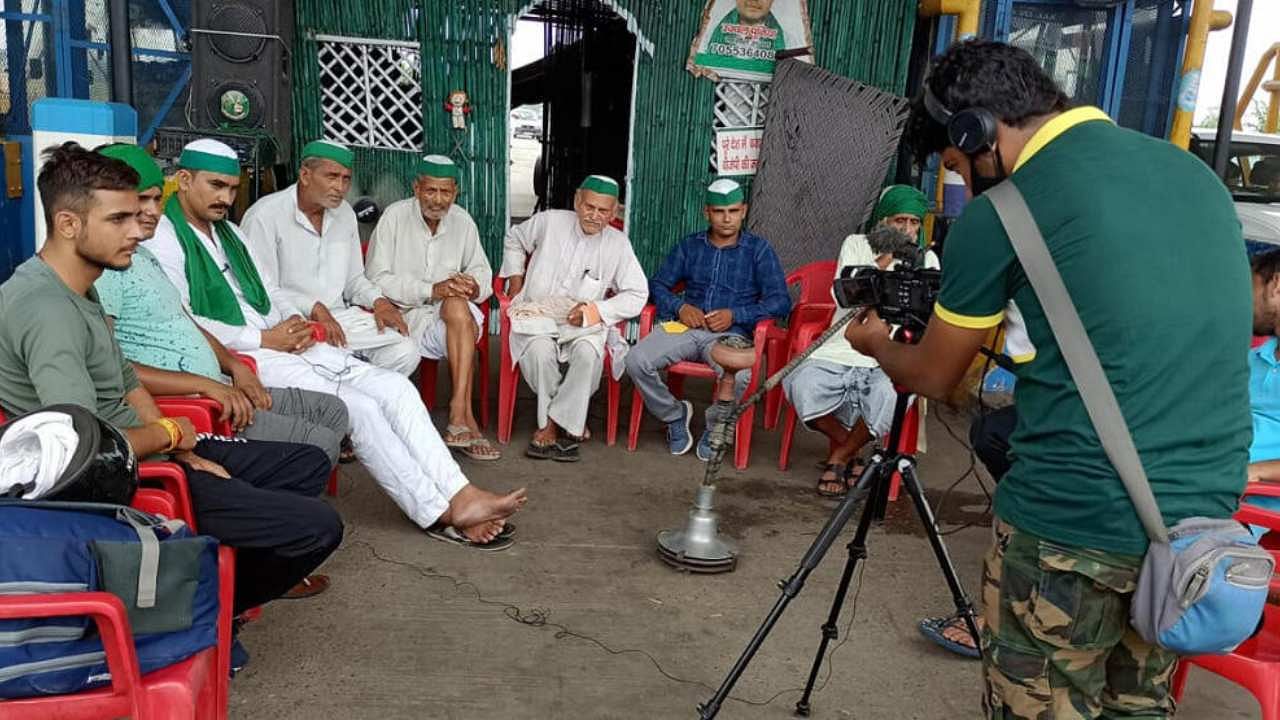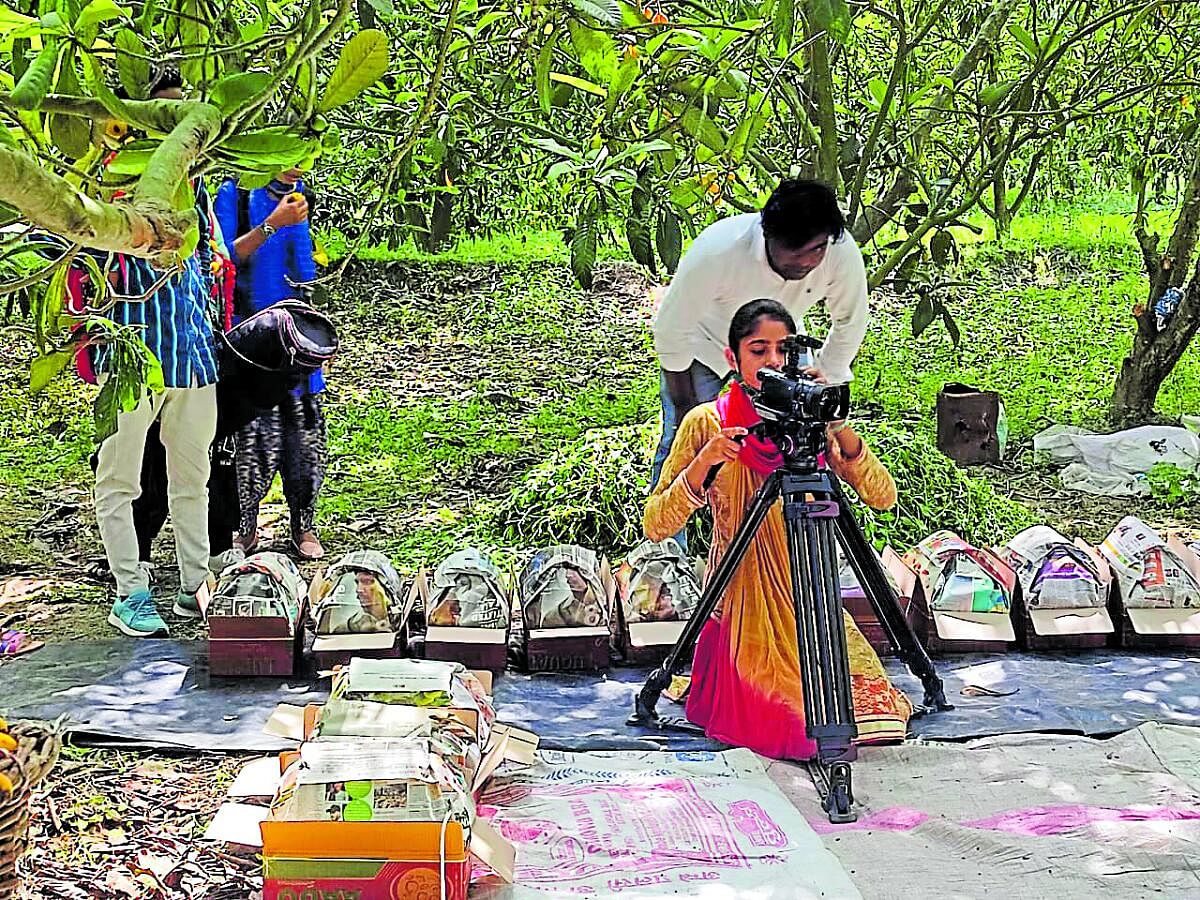

Ikra Ayyub Saifi from Kandhla village in Shamli District is all of 18, but somewhere she had read that the Minister of State for Petroleum and Natural Gas, Rameshwar Teli, had admitted in the Rajya Sabha in August 2022 that 4.13 crore beneficiaries of the Prime Minister Ujjwala Yojana (PMUY) have not refilled cylinders even once in the last five years.
And that fact, she realised, could be the peg of her story. After discussing it with her colleagues, Ikra went about reporting and filming the news story herself.
Ikra is one of the few girls from her village who is part of Chal Chitra Abhiyan (CCA), a media and film collective that makes short documentaries and newsreels about issues affecting the common and marginalised people that are often overlooked by the mainstream media.
The collective, based in Shamli in western UP, is training people from the local communities to tell their own stories, edit them, and decide cultural interventions on the ground, if need be.
It covers five districts of western UP: Meerut, Saharanpur, Shamli, Muzaffarnagar, and Baghpat. In the sugarcane farming belt, these areas are rich, industrialised, and urbanised but have one of the lowest sex ratios and literacy rates in the country. The area also has a large Muslim and landless Dalit population.
The founder of CCA, Nakul Sawhney, a documentary filmmaker himself, says while filming his documentary Muzaffarnagar Abhi Baqi Hai in 2013, he found that fake news was rampant and videos on social media vitiated the atmosphere further. There was none countering such fake news. And CCA tries to fill that gap.
Moreover, in a country where the media is under threat from growing restrictions, arbitrary arrests, and raids, CCA is trying to democratise the media, which is particularly under scanner in UP, by making it
more inclusive.
According to the Committee Against Assault on Journalists 2022 report, 66 journalists are facing criminal cases, and 48 journalists have been physically attacked in UP. Journalists reporting in Hindi from small towns and villages are at a higher risk of being targeted and persecuted
by authorities.
Amidst such restraints, CCA is working with a small team comprised of people from the grassroots as its reporters, who, until recently, did not even know how to use a smartphone.
Nakul says, “CCA was an idea to get a sense of reality, to dispel the fake news, and highlight issues that affect common people, especially the marginalised. People have realised the importance of authentic news.”
Nakul adds that there was a need for alternate media in a decentralised space, and that is how CCA evolved as part of a churn—locally and organically. Some youngsters were interested in dispelling the fake news. “And as we wanted local and marginalised people to tell their stories—or, ideally, own their stories.”
Six years in the running, CCA has reporters like Vishal Stonewall, a former brick kiln worker from the Dalit community; Shakib Yameen Rangrez, a 2013 Muzaffarnagar riots survivor; Savez Chauhan, a member of the sugarcane farming community; and many others who are now trained reporters, editors, camerapersons, and aspiring documentary filmmakers.
Vishal Stonewall, 28, who worked in the brick kiln before he joined an NGO, got interested in recording news videos and documentaries after he met Nakul. Vishal learned the nuances of filming stories on the job. When he assisted Nakul in filming a documentary, he realised the hatred and unnecessary polarisation between communities kindled by social media and viral videos. Moreover, issues like water scarcity, poverty, and unemployment in his area made him angry. He says, “Although I am a BEd, I find reporting useful for our village community. By truthfully presenting the facts in the form of a news feed and even making documentaries on a larger scale, I feel satisfied.”
He says their region being a sugarcane belt, there are problems plaguing the small-scale farmers and the sugarcane mill workers, whose stories are not reported by the mainstream media. CCA is trying to raise their issues.
But Vishal says speaking truth to power has its fallout. There have been instances when they have faced threats from the police and detentions, yet they have not backed out. They have been relentlessly disseminating facts, which are often picked up by the national media and amplified.
And that is why CCA recently won the Social Media for Empowerment Award under the Power of People and Participation 2022–23 category. This award is given by the Council for Social and Digital Development, the Digital Development Foundation, and the World Summits Award.
Through their reportage on farmers in the area, attacks on Dalit landless farm workers, or police brutality against Muslims, CCA has often pushed the national media to take note of what is happening in these areas, just three hours from the national capital.
On an incident reported by the mainstream media, picked up only after CCA pursued it unwaveringly, Nakul says: “In 2017, in Shabbirpur, a small Rajput-dominated village in Saharanpur district, Dalits were attacked and their houses were burnt down. There, 13 Dalit women went on hunger strike, demanding revocation of the National Security Act, which had been applied against two Dalits and against Chandrasekhar, founder of the Bhim Army. There were major caste tensions between Rajputs and Dalits, and a lot of fake news was being circulated. We covered what was actually going on and tried to dispel the rumours that were further escalating the tensions. We were able to get the national media to pick up the real narrative.”
Nakul adds: “Through our stories, we try to put pressure on the administration to act. Our team has done stories ranging from cow slaughter to farmers to healthcare to gender disparity. We have tried to bring out the voices of the working class and highlight the human rights violations. When the mainstream media obliterated many of the stories of the Bhim Army, which is a pro-Dalit group fighting for Dalit rights, we filmed and documented their stories and their efforts to get justice for the marginalised people. We try to counter false propaganda. Like in the other Kairana episode, the media turned it into a Hindu-Muslim narrative and only talked about the Hindu exodus because of Muslim atrocities. We then not only deconstructed the narrative, debunked the lies but also looked beyond the communal lens. We brought out the issues of unemployment, gender discrimination, and poverty, which were also causes for the exodus. And in all our stories, we foregrounded the real issues
of Kairana.”
CCA’s videos on real issues are disseminated through their websites, YouTube channels, and by young people who amplify the actual news and counter the fake ones.
Shakib Yameen Rangrez, a 23-year-old college student, says he lived through the hardships in the refugee camp, including the hatred towards their community. He says: “Whatever we film, we put on social media, and we have a group that further disseminates the news on social media, countering the fake news.”
What is unique about CCA’s dissemination plan is that they take their video news stories to people across villages, showing them in makeshift setups on projectors. Alongside, they also show international films and documentaries in villages and several townships in Shamli and Muzaffarnagar districts.
Amplifying the real issues has made the villagers aware of their problems and how to make the administration see the reason behind their demands.
Vishal says, “The film shows, which we have been holding in villages, are now welcomed by the villagers. Earlier, there was hesitation about the reasons for showing films. Now that all five single-screen theatres in the area have shut down and the closest one is at least 60 km away, these film shows have become popular with villagers. They have understood that collective viewing of quality cinema and authentic news reports, followed by discussions after the screening, is the most effective way to counter fake news. Also, there is informed discussion among the villagers about what is happening in the world. Every week, 90–100 people have been coming together in at least 15–16 villages for this for the past three years. They discuss news and also critique global cinema.”
Unemployment, price rises, schools, colleges, and healthcare are the core issues that affect the villagers. Yet people carry on with whatever facilities the government has given them. Shakib says: “Till now, most are not aware of their rights. They watch protests but do not know how to pursue their own agitations. As part of the community, we also face the same problems. We shoot the stories, show them the end products, and question the local officials too.” But all this is done on a shoestring budget and with the help of some donors.
Shakib says: “Unemployment is the biggest issue here. There are no colleges or universities in Kandhla, no proper health care or hospitals. Anybody who has major health issues would have to travel hundreds of kilometres to either Meerut or Delhi. But these are never reported on. When the CCA holds collective film screenings, villagers discuss these issues.”
Shakib goes on to talk about problems of land acquisition, compensation issues, stray animal problems, and others. He says the livelihoods of small farmers have been drastically affected by Covid, but nobody is raising their issues. “So we try to voice our own issues.”
Shoma Chatterji, film critic and author of ‘The Independent Documentary Movement in India,’ says: “Independent and alternative filmmakers’ believe that this fight to create, sustain, and promote independence is not about films and censor certificates but is a larger fight to hold on to their rights and their democratic norms. As filmmakers and storytellers, public opinion is an important part of their struggle, and they believe it is essential to energising a strong screening culture. In trying to evolve this alternative language through an alternative cinema, crusaders of public causes are struggling to bring about a happy marriage wherever possible between art and activism, between creativity and political action.”
There are other grassroots collectives that are now trying to change the nature of media by democratising it by reporting for and by the working classes. Like the Cinema of Resistance, a grassroots film screening initiative that started in 2006 in Gorakhpur and focuses on bringing alternative films or new cinema to the people, they organise film festivals to educate and inform in the hope that it will inspire like-minded people to watch films and documentaries and awaken them to reality.
Another movement called the People’s Film Collective is an independent, autonomous, people-funded cultural-political collective based in West Bengal. Formed in 2013, it believes in the power of films as a weapon of pedagogy of the oppressed and as alternative media for people. It travels in Bengal with films and videos.
(The writer is a senior journalist based in Delhi)